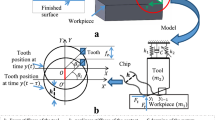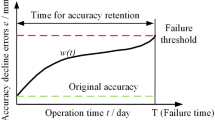Abstract
An accurate cutting force model of ball-end milling is essential for precision prediction and compensation of tool deflection that dominantly determines the dimensional accuracy of the machined surface. This paper presents an improved theoretical dynamic cutting force model for ball-end milling. The three-dimensional instantaneous cutting forces acting on a single flute of a helical ball-end mill are integrated from the differential cutting force components on sliced elements of the flute along the cutter-axis direction. The size effect of undeformed chip thickness and the influence of the effective rake angle are considered in the formulation of the differential cutting forces based on the theory of oblique cutting. A set of half immersion slot milling tests is performed with a one-tooth solid carbide helical ball-end mill for the calibration of the cutting force coefficients. The recorded dynamic cutting forces are averaged to fit the theoretical model and yield the cutting force coefficients. The measured and simulated dynamic cutting forces are compared using the experimental calibrated cutting force coefficients, and there is a reasonable agreement. A further experimental verification of the dynamic cutting force model will be presented in a follow-up paper.
Similar content being viewed by others
References
Smith S, Tlusty J (1991) An overview of modelling and simulation of the milling process. Trans ASME J Eng Ind 113(2):169–175
Feng H-Y, Menq C-H (1994) The prediction of cutting forces in ball-end milling process—I. Model formulation and model building procedure. Int J Mach Tools Manuf 34(5):697–710
Feng H-Y, Menq C-H (1994) The prediction of cutting forces in ball-end milling process—II. Cut geometry analysis and model verification. Int J Mach Tools Manuf 34(5):711–719
Shaw MC (1984) Metal cutting principles. Oxford University Press, Oxford
Feng H-Y, Menq C-H (1996) A flexible ball-end milling system model for cutting force and machining error prediction. Trans ASME J Manuf Sci Eng 118(4)461–469
Lim EM, Feng H-Y, Menq C-H, Lin ZH (1995) The prediction of dimensional errors for sculptured surface productions using the ball-end milling process. Part I: Chip geometry analysis and cutting force prediction. Int J Mach Tools Manuf 35(8):1149–1185
Yang M, Park H (1991) The prediction of cutting force in ball-end milling. Int J Mach Tools Manuf 31(1):45–54
Sim C, Yang M (1993) The prediction of the cutting force in ball-end milling with a flexible cutter. Int J Mach Tools Manuf 31(2):267–284
Yucesan GB, Altintas Y (1996) Prediction of ball-end milling forces. Trans ASME J Eng Ind 118(1):95–103
Altintas Y, Lee P (1998) Mechanics and dynamics of ball-end milling. Trans ASME J Manuf Sci Eng 120(4):684–692
Budak E, Altintas Y, Armarego EJA (1996) Prediction of milling force coefficients from orthogonal cutting data. Trans ASME J Manuf Sci Eng 118(2):216–224
Yucesan GB, Altintas Y (1994) Improved modelling of cutting force coefficients in peripheral milling. Int J Mach Tools Manuf 34(4):473–487
Lee P, Altintas Y (1996) Prediction of ball-end milling forces from orthogonal cutting data. Int J Mach Tools Manuf 36(9):1059–1072
Abrari F, Elbestawi MA (1997) Closed form formulation of cutting forces for ball and flat end mills. Int J Mach Tools Manuf 37(1):17–27
Imani BM, Sadeghi MH, Elbestawi MA (1998) An improved process simulation system for ball-end milling of sculptured surfaces. Int J Mach Tools Manuf 38(9):1089–1107
Lazoglu I, Liang SY (2000) Modelling of ball-end milling forces with cutter axis inclination. Trans ASME J Manuf Sci Eng 122(1):3–11
Tai CC, Fuh KH (1994) A predictive force model in ball-end milling including eccentricity effects. Int J Mach Tools Manuf 34(7):957–979
Author information
Authors and Affiliations
Corresponding author
Rights and permissions
About this article
Cite this article
Liu, XW., Cheng, K., Longstaff, A. et al. Improved dynamic cutting force model in ball-end milling. Part I: theoretical modelling and experimental calibration. Int J Adv Manuf Technol 26, 457–465 (2005). https://doi.org/10.1007/s00170-003-2014-2
Received:
Accepted:
Published:
Issue Date:
DOI: https://doi.org/10.1007/s00170-003-2014-2




